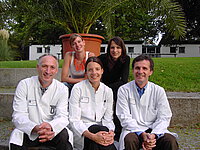Treadmill-training in Hereditary Spastic Paraplegia: Effects on Cortico-Spinal Reflex-modulation, Walking und Quality of Life
Applicants: Dr. Bernhard Heimbach , Dr. Maike Hodapp, PD Dr. Michael Faist
Universitätsklinikum Freiburg, Klinik für Neurologie und klinische Neurophysiologie Breisacher Strasse 64, 79106 Freiburg
Hereditary Spastic Paraplegia (HSP) is a neurodegenerative disorder. Clinically, the main symptom is a progressive spastic paraparesis which leads to an increasing dependency on nursing and supportive devices (crutches, wheel-chair). As there is no curative therapy symptomatic treatment consisting of antispastic medication, local application of botulinum toxin A and especially physiotherapy becomes essential. Physiotherapy is the basic treatment at every stage of the disease. So far it is not clear, if there are differences between several methods of physiotherapy regarding functional stability, quality of life or HSP-typical complaints (e.g. backache). Moreover it remains unclear at which stage of the disease, which frequency, duration and method of physiotherapy should be applied.
While wheel chair dependent patients with spasticity are preferably conventionally treated by general mobilizing techniques to prevent muscle contraction, ambulant patients with spasticity are preferably treated with neurophysiological techniques to maintain mobility such as standing and walking (DGN-guidelines 2005 www.dgn.org).
Treadmill training can improve gait parameters in some spastic patients clinically. This was shown for children suffering from cerebral palsy (Schindl et al. 2000, Day et al. 2004, Dodd and Foley 2007, Provost et al. 2007, Cherng et al. 2007) and partly for adult stroke patients (Hesse et al. 1995). In a cochrane review no overall statistical effect of treadmill training in stroke patients was detected (Moseley et al. 2003).
Comparing neurophysiological techniques with new methods of physiotherapy e.g. forced use therapy with task-specific, repetitive training and shaping techniques (Hamzei et al 2004) or treadmill-training activating the spinal reflex modulation, the new methods seem to be more effective in improving ambulation in spasticity associated diseases as incomplete paraplegia/tetraplegia after spinal cord injury or hemipareses after stroke (Logigan et al 1983, Hesse et al 1995, Wernig et al 1995 b).
In outpatient physiotherapy-departments the new methods of physiotherapy are not performed in HSP-patients. Usually patients are treated with conventional and neurophysiological techniques. Comparing the different techniques (conventional / neurophysiological / combination of both) the combination of conventional and neurophysiological methods have been subjectively assessed by the patients as the most effective (Heimbach et al 2004). In a HSP-case report described by Richardson the combination of different methods in physiotherapy with task-specific and repetitive training diminished depletion, numbers of falls and backaches significantly (Richardson et al 1999). This supports the hypothesis that less the method itself is relevant than the convenient mixture of different techniques to achieve the therapeutic goal.
The role of new methods of physiotherapy, especially treadmill-training, with HSP-patients, has not been evaluated empirically so far.





